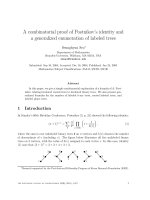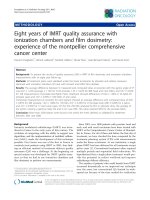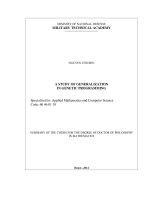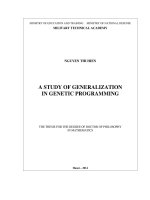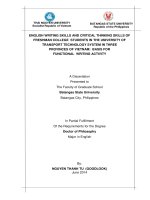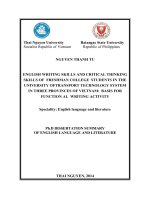ETHNIC IDENTITY AND CULTURAL ADAPTATION EXPERIENCE OF ETHNIC MINORITY STUDENTS = căn TÍNH tộc NGƯỜI và TRẢI NGHIỆM hòa NHẬP văn hóa của SINH VIÊN dân tộc THIỂU số
Bạn đang xem bản rút gọn của tài liệu. Xem và tải ngay bản đầy đủ của tài liệu tại đây (484.07 KB, 67 trang )
VIETNAM NATIONAL UNIVERSITY, HANOI
UNIVERSITY OF LANGUAGES AND INTERNATIONAL STUDIES
FACULTY OF LINGUISTICS & CULTURES OF ENGLISH-SPEAKING COUNTRIES
GRADUATION PAPER
ETHNIC IDENTITY AND CULTURAL ADAPTATION
EXPERIENCE OF ETHNIC MINORITY STUDENTS
Supervisor: Nguyễn Thanh Hà, Ph.D
Student: Phạm Khánh Duyên
Course: QH2017. F1. E3
HÀ NỘI – 2021
ĐẠI HỌC QUỐC GIA HÀ NỘI
TRƯỜNG ĐẠI HỌC NGOẠI NGỮ
KHOA NGƠN NGỮ VÀ VĂN HỐ CÁC NƯỚC NĨI TIẾNG ANH
KHĨA LUẬN TỐT NGHIỆP
CĂN TÍNH TỘC NGƯỜI VÀ TRẢI NGHIỆM HỊA
NHẬP VĂN HÓA CỦA SINH VIÊN
DÂN TỘC THIỂU SỐ
Giáo viên hướng dẫn: TS. Nguyễn Thanh Hà
Sinh viên: Phạm Khánh Duyên
Khóa: QH2017. F1. E3
HÀ NỘI – 2021
Supervisor’s approval
____________________________________________________
I hereby state that I: Phạm Khánh Duyên, 17E3, being a candidate for the
degree of Bachelor of Arts (English Language Teacher Education) accept the
requirements of the College relating to the retention and use of Bachelor’s
Graduation Paper deposited in the library.
In terms of these conditions, I agree that the origin of my paper deposited in
the library should be accessible for the purposes of study and research, in
accordance with the normal conditions established by the librarian for the care,
loan or reproduction of the paper.
Signature
May 3rd , 2021
ACKNOWLEDGEMENT
Firstly, I would like to express my sincere gratitude to my research supervisor,
Dr. Nguyen Thanh Ha, for her great assistance and encouragement. I really
appreciate her precious time and her enthusiasm for reviewing and giving feedback
on my work. They contributed to improving my research and helped me gain
valuable insights on academic writing and widened my general knowledge. Without
her specific instructions and tremendous spirit, I would not have been motivated
enough to complete the dissertation for the best.
Secondly, I highly value and respect all the lecturers in the Faculty of
Linguistics and Cultures of English-speaking Countries for their kind support during
the research time. Their comments on the progress reports were of invaluable help
for my study. Particularly, I am extremely grateful to Dr. Hanh Hoang for her clear
and comprehensive instruction in conducting research as well as her regular
reminders. Those greatly helped me to keep track of the schedule and meet the
deadlines on time.
I would also like to give my warmest thanks to my family and all of my
friends for their wholehearted support, especially when I was under pressure and
discouraged. Thank you, Dung and Yen, for always standing by my side and
backing me up from the beginning of the thesis to its completion.
Last but not least, I want to thank all participants in my research. Had it not
been for their open-mindedness to share their stories, I could not have collected such
detailed and comprehensive data and figured out interesting findings for the study.
I
ABSTRACT
Prior research on the ethnic identity of college students from a minority group
has often focused on racial, rather than cultural elements. The Vietnamese context,
where the population is generally racially homogeneous but culturally diverse with
Kinh as the predominant group, therefore, raises a different set of questions. This
case study involves four ethnic minority students in the Faculty of English Language
Teacher Education (FELTE), University of Languages and International Studies
(ULIS), and explores how they see themselves in relation to their ethnic groups and
how they adapt to life in Hanoi and at ULIS as cultural minorities. Through in-depth
interviews and based on Phinney’s concept of ethnic identity (1990), Cervantes and
Cordova’s (2011) framework of acculturative stress and Berry and Sam’s (2006)
cultural adaptation patterns, the study presented some significant findings. First, the
strength of ethnic self-image varies among the participants and is manifested
differently in their self-labelling, attitudes and relationship with their ethnic
communities, and involvement in cultural traditions and daily practice. Second, their
adaptation seems to follow different patterns, ranging from Separation (strong
attachment to their ethnic group at the expense of learning the new culture) to
Assimilation (immersion in the dominant culture and limited attachment to their
original ethnic group), and Integration (maintenance and strengthening of ethnic
identity while adapting to the new culture). In addition, the participants experience
some common stressors such as communication problems, cultural shock,
challenges with learning English and other academic difficulties. This case study
highlights the importance of further support from academic institutions and
sensitivity from the dominant community.
II
TABLE OF CONTENT
ACKNOWLEDGEMENT......................................................................................................i
ABSTRACT...........................................................................................................................ii
TABLE OF CONTENT.......................................................................................................iii
CHAPTER I. INTRODUCTION.........................................................................................1
1.1. Statement of the Research Problem and Rationale.......................................................... 1
1.2. Scope of the Study............................................................................................................3
1.3. Significance of the Study................................................................................................. 3
CHAPTER I. INTRODUCTION.........................................................................................4
2.1. Ethnic Identity.................................................................................................................. 4
2.1.1. Ethnic Identity Definition and Development.........................................................4
2.1.2. Ethnic Identity Construction: Phinney’s Framework (1990).................................5
2.1.3. Ethnic Identity Salience......................................................................................... 8
2.2. Cultural adaptation........................................................................................................... 9
2.2.1. Definition............................................................................................................... 9
2.2.2. Acculturative Stress............................................................................................. 10
2.2.3. Cultural Adaptation Patterns................................................................................13
CHAPTER III. METHODOLOGY.................................................................................. 16
3.1. Participants..................................................................................................................... 16
3.2. Data Collection...............................................................................................................17
3.3. Data Analysis................................................................................................................. 18
CHAPTER IV. FINDINGS AND DISCUSSION............................................................. 19
4.1. Ethnic Identity................................................................................................................ 19
4.1.1. Hoa’s Strong Ethnic Identity as a Dzao Person................................................... 19
4.1.2. May’s Strong Ethnic Identity as a H’mong Person............................................. 22
4.1.3. An’s Mixed Ethnic Identity................................................................................. 24
4.1.4. Trung’s Weak Ethnic Identity..............................................................................27
4.1.5. Discussion of Ethnic Identity...............................................................................29
III
4.2. Experience of Acculturative Stress................................................................................ 32
4.2.1. Language and Communication Stress..................................................................32
4.2.2. Academic Stress...................................................................................................33
4.2.3. Social Stress in Hanoi.......................................................................................... 35
4.2.4. Economic Stress...................................................................................................37
4.2.5. Discussion of Acculturative Stress...................................................................... 38
4.3. Adaptation Patterns........................................................................................................ 39
4.3.1. Hoa’s Separation Tendency................................................................................. 39
4.3.2. May’s Strong Integration..................................................................................... 42
4.3.3. An’s Partial Integration........................................................................................44
4.3.4. Trung’s Assimilation Tendency...........................................................................46
4.3.5. Discussion of Adaptation Experience..................................................................48
CHAPTER V. CONCLUSION.......................................................................................... 50
5.1. Summary of Findings..................................................................................................... 50
5.2. Implications....................................................................................................................51
5.3. Limitations and Suggestions for Further Studies........................................................... 52
REFERENCE ................................................................................................................... 584
APPENDIX..........................................................................................................................58
IV
CHAPTER I. INTRODUCTION
1.1. Statement of the Research Problem and Rationale
As migration and mobility has significantly increased nowadays, many
individuals or groups from non-dominant cultures now live, study, and work within
a majority culture. As they move to a new culture, the newcomers are not only
attached to their heritage community but are also in contact with the dominant
culture. As a result, much attention has been paid to how they see themselves and
how they get adapted to the new society.
Most big universities and colleges are home to an ethnically diverse student
population. Many researchers have studied minority students and explored their
ethnic identity and cultural adaptation. For example, Phinney (1992) focused on the
identity of ethnically and racially diverse students in the US, including Asian
American, African American, Hispanic and Whites. With the same scope of
participants, Bernal, Saenz and Knight (1991) and Santos et al. (2007) explored the
relationship between ethnic identity and student adjustment in ethnically diverse
schools in the US. Verkuyten and de Wolf (2002), interested in the same
phenomenon, involved Chinese students studying in the Netherlands. Research has
also been done on the acculturation and adaptation of students from different
cultures such as Barger’s (1977) comparative study of Inuit (Eskimo) and Indians in
Quebec, Canada.
It could be seen from those studies that race is more of a concern than
ethnicity. In other words, researchers often focus on demographic aspects and
racially recognizable factors such as skin color instead of ethnic elements, which are
“socially and culturally constructed” (Mooney & Evan, 2015, p. 133). In fact, not
much research has been conducted on the ethnic identity and adaptation experience
of those belonging to the same racial group but different ethnic communities.
1
In Vietnam, students from 53 ethnic minority groups attend colleges and
universities with those of the dominant culture, the Kinh people. The ethnic identity
of those from minority groups is often poorly represented with many stereotypes,
simplifications, and inaccuracies. For example, they are normally assumed by the
larger society to live in remote areas with backward, poor living conditions and low
academic performance. Moreover, when moving to a new society, they may
experience cultural shock and challenges in adapting to the language, beliefs, values
or practices of the new environment, which may be further exacerbated by the
society's misunderstandings and lack of awareness of their culture. While policies
such as financial support, bonus scores or direct offers to university can be helpful in
facilitating their academic achievement, more attention should be paid to how they
manage in such a new environment, and what social and cultural support may be
necessary.
University of Languages and International Studies (ULIS) is also a
multicultural environment since it gathers students from various ethnic groups such
as Kinh, Tay, Muong, Dzao and so on. Nevertheless, there has been very little
research focusing on how ULIS minority students identify themselves ethnically and
how they adapt to both the academic environment and the life in Hanoi.
As a senior in the Faculty of English Language Teacher Education (FELTE)
who has friends from different ethnic groups, I have recognized the different levels
of their performances both academically and socially. While most of them tend to
hide their ethnic background and have negative experiences, others experience few
difficulties when moving to the new culture. Particularly, some are exceptionally
outstanding and seem to be well-adapted to the dominant society. I am curious about
what underlies these differences and find it significant to conduct this study for more
insights into how FELTE ethnic minority students identify themselves and their
adaptation process.
2
This study focuses on two main questions:
1. How do the participants identify themselves ethnically?
2. How did the participants experience cultural adaptation in the new
environment?
The second question involves two sub-questions, one focusing on the
acculturative stressors that the participants encountered in the new culture and the
other looking at their overall adaptation patterns.
1.2. Scope of the Study
The study focuses on the ethnic identity and adaptation experience of four
senior students in FELTE, ULIS. They come from different ethnic minority groups,
including Tay, Thai, Dzao and H’Mong.
The participants were chosen for the following reasons: (1) The various
ethnic groups of participants help maximize the diversity of the data; (2) The study
focuses on last year students as they have developed a stable identity and become
well-aware of their situation; (3) As this project is a qualitative case study requiring
in-depth stories and experience of participants, four is an appropriate number of
interviewees that I could handle while lessening the risk of oversimplification and
overgeneralization.
1.3. Significance of the Study
The research contributes to the limited literature on ethnic identity and
adaptation experience of ethnic minority students in Vietnam, especially as they
attend colleges and universities with students from the majority culture. It also hopes
to inspire more understanding among stakeholders and strategies to better support
these students in their academic and social life.
3
CHAPTER II. LITERATURE REVIEW
2.1. Ethnic Identity
2.1.1. Ethnic Identity Definition and Development
While it is generally agreed that ethnic identity is a dynamic, complex, and
multidimensional construct (Cohen, 2004), its exact definition varies among many
researchers, indicating dissensus about conceptualizing this term (Phinney, 1990).
One popular definition proposed by Cohen (2004) states that ethnic identity refers
to a person’s social identity within a larger context based on membership in a
cultural or social group. Based on this idea, other researchers have operationalized
the term in different ways, employing one of these two following approaches. In the
first approach, ethnic identity is described through the interaction of individuals with
different cultural aspects of their ethnic group such as language, behavior, values,
cultural habits, and knowledge of ethnic group history (e.g., Rogler, Cooney, &
Ortiz, 1980; Phinney, 1992, 1990). In contrast, the second approach emphasizes the
key aspects of an individual when exposed to the ethnic society, including cognition,
emotion, and behavior (Fishbein, 1965). Depending on their purposes, researchers
may focus on different aspects. For example, Tajfel (1981), Phinney (1990), and
Brittain, Taylor, and Derlan (2013) focused on self-identification and the sense of
belonging to an ethnic group, which belong to the cognitive dimension. Meanwhile,
other scholars defined ethnic identity with the focus on the feelings and attitudes
towards one’s group (Parham & Helms, 1981). The behavioral aspects (social
interaction, language use, cultural habits, etc.) were at the center of research by
Rogler, Cooney, and Ortiz (1980).
From a developmental perspective, Phinney (1993), Umaña, Yazedjian and
Gómez (2004) proposed three levels of ethnic identity based on the individual’s
psychological functioning, which is their ability to understand their ethnic identity
with respect to their ethnic groups. Those levels included: Exploration, Resolution
4
and Affirmation. The Exploration level involves the continuum of questioning
oneself to figure out their ethnic identity, and the exposure to the new environment
to increase their own understanding about their ethnicity. Those at the Resolution
level are already aware of what their ethnic group membership means to their ethnic
identity, where they belong and the meaning of ethnicity to their lives. In the
Affirmation stage, individuals not only understand their ethnic identity but they also
present an effort to maintain a positive self-concept and achieve a positive social
identity.
2.1.2. Ethnic Identity Construction: Phinney’s Framework (1990)
There is still no consensus on the components that constitute ethnic identity
(Drydakis, 2012). Bui, Ngo and Nguyen (2019) and other researchers highlighted
five interrelated components, including family background, previous academic,
residential area, socio-cultural factors and language. However, among many types of
categorization, the framework proposed by Phinney (1990) is widely accepted as it
presents ethnic identity from a more comprehensive perspective. According to
Phinney (1990), the ethnic identity of an individual comprises the key components:
Self-identification as a group member, sense of belonging to the group, attitudes
about one's group membership, and ethnic involvement (social participation, cultural
practices and attitudes). Below is a detailed description of these elements.
2.1.2.1. Ethnic Self-Identification (Self-Labeling)
Self-identification (or self-labeling) refers to the ethnic label that one uses for
oneself. The label that one uses for his/herself may greatly differ from the ethnicity
that was determined by descent or parental background (Phinney, 1990)
It was also observed by Phinney (1990) that members living in one ethnic
minority group can label themselves either as only “partly ethnic” or “partly
mainstream.” Meanwhile, individuals living in an originally mixed culture may have
5
more than one label from different cultural groups. As a result, they often regard
themselves as mixed or completely ignore one part of their heritage and show
preference for their other culture. In fact, the label one chooses to call themselves
may indicate different connotations about their ethnic identity.
2.1.2.2. Sense of Belonging to Ethnic Group
Labeling oneself with a specific ethnicity does not necessarily mean that one
has a sense of belonging to that culture. Therefore, it is an independent component
of ethnic identity. According to Phinney (1990), it includes two main dimensions:
Being part of a cultural group. Individuals may feel strong bonds towards
their own ethnic group; consider their fate and future bound up with that of their
group; or feel an overwhelming attachment to it.
Not being a part of other groups. Together with the feeling of membership in
one group, individuals can obtain a sense of belonging to their ethnic group through
the experience of exclusion, difference, contrast, or separateness from other groups.
2.1.2.3. Positive and Negative Attitudes Towards One’s Ethnic Group
In addition to an ethnic sense of belonging and self-identification, ethnic
identity could be illustrated by the positive and negative attitudes of members
toward their own ethnic group.
Positive Attitudes manifest as pride, pleasure, satisfaction or contentment
with their own group. Specifically, group members may feel “proud to be ethnically
identified,” regard their own culture as “rich and precious,” or feel good about their
cultural background (Phinney, 1990, p. 504).
Negative Attitudes could be considered an indirect denial of one's ethnic
identity, which may often happen with members of a minority group. They include
displeasure, dissatisfaction, discontentment with one's ethnicity; feelings of
6
inferiority; tendency to hide one's cultural identity, wish to change their group
membership status if they were born again, and so on. Particularly, individuals may
present negative attitudes to other members of their own group and show a
preference for the dominant culture. Their consideration of their group residents as
socially, economically and intellectually inferior to those of dominant (often
mainstream) culture is a typical example of this aspect (Phinney, 1990).
2.1.2.4. Ethnic Involvement (Social Participation and Cultural Practices)
Phinney (1990) noted that the indicators of ethnic involvement include
language, friendship, religion, ethnic social group, political ideology, residential area
and cultural traditions, activities and attitudes.
(a) Language. The ethnic identification of an individual can be indicated
through the frequency of using the language, their language competence and the
decision of retaining their language when migrating to the mainstream environment.
(b) Friendship. The relationship with friends also defines their ethnic identity
through one's attitudes towards the importance of ingroup friends, preference for ingroup dating as well as the ethnic background of friends.
(c) Religion. Religion as one manifestation of ethnic identity refers to
religious affiliation and practice, including church membership, attendance in
religious ceremonies, religious educational institutions such as parochial school, and
religious preference.
(d) Structured Ethnic Social Groups. One’s participation in ethnic clubs,
societies, or organizations is considered a component of ethnic identity.
(e) Political Ideology and Activity. They are defined as involvement in
political activities on behalf of one's ethnic group, including political ideology and
active participation in political organizations.
7
(f) Area of Residence. The geographical region can also in part indicate the
ethnic identity of an individual. Moreover, it could be identified through the number
or the proportion of in-group members in one’s area. In other words, whether they
live in a mixed neighborhood where other groups’ members also settle can also
affect their ethnic identity.
(g) Ethnic Cultural Activities and Attitudes. It is important to study one’s
ethnic identity through a wide variety of specific cultural activities and attitudes.
Several key items are
ethnic music, songs, dances, and dress; newspapers,
periodicals, books, and literature; food or cooking; entertainment (movies, radio, TV,
plays, sports, etc.); traditional celebrations; traditional family roles, values, and
names; the practice of endogamy or opposition to mixed marriages; and knowledge
about ethnic culture or history.
2.1.3. Ethnic Identity Salience
It is widely agreed that ethnic identity is not fixed but varies in strength,
forming ethnic identity salience (Phinney, 1991, Toomey et al., 2000).
Ethnic identity salience involves the extent to which individuals hold their
ethnicity to be of importance and whether it can be noticed easily (Toomey et al,
2000). There is a difference between majority and minority identities. According to
Brewer (1991) and Nandi and Platt (2016), dominant group members often have
weaker ethnic identity than those in minority groups as they tend to have little
awareness of their ethnicity. Among minorities, ethnic identity salience also varies
on a continuum from strong to weak. Those with strong ethnic identity often label
themselves as “group members, evaluate their group positively, prefer or are
comfortable with their group membership, are interested in, knowledgeable about,
and committed to the group, and are involved ethnic practices'' (Phinney, 1991, p.
194). In contrast, individuals with weak ethnic identity salience have “little ethnic
8
interest, knowledge, commitment, or involvement, and negative evaluation of the
group and of one's membership in the group'' (Phinney, 1991, p. 194).
Ethnic identity salience may be affected by different ethnic factors. For
example, parental education backgrounds and the ethnicity of individuals may
influence their early education and their daily practices of culture. Various types of
schools may provide different academic backgrounds and experience of ethnic
students in interacting with the broader society. Whether they live in separated areas
or mixed with other communities also affect their acquisition of culture and
understanding about their ethnicity. Moreover, the uniqueness of cultural practices
and languages could increase the attachment of ethnic students (Bui, Ngo & Nguyen,
2019). This results in diverse identification strengths, or ethnic identity salience.
2.2. Cultural adaptation
2.2.1. Definition
Berry defined adaptation as “the long-term ways in which people rearrange
their lives and settle down to a more-or-less satisfactory existence in response to
external demands” (2006, p. 48). Specifically, cultural adaptation is highlighted as
“the dynamic process” by which the newcomers negotiate and adjust themselves in
terms of attitudes and behaviors when moving to a new, unfamiliar culture (Su, He
& Huang, 2019). Through adaptation, the newcomers create and maintain “relatively
stable, reciprocal, and functional relationships with the members of other groups,”
survive and live comfortably in a different cultural environment (Su, He & Huang,
2019, p. 2). Wang and Yang (2019) looked at adaptation in a bi-dimensional
approach and emphasized the continuous interaction among members of both
cultures, rather than one-way adjustment of those from a different culture to the host,
mainstream culture.
9
It has been demonstrated by many researchers that there are two main
dimensions to adaptation behaviors. According to Sam and Berry (2006), cultural
adaptation can be considered the process of “adoption of the society or rejection of
or resistance to cultural elements” (p. 11). In other words, newcomers can have two
different ways to well survive in the new environment: Some people inevitably and
completely change towards greater similarity with the host culture to get a sense of
belonging to this community, whereas some others may maintain or just slightly
modify their traditional lifestyles to survive in the new culture (Berry, 2005).
Regarding the adaptation process, there are two main phases that groups or
individuals may go through when moving to a new culture (Sam & Berry, 2006). In
the beginning, newcomers are exposed to the new culture and start to learn new
social elements. During that process, they may experience some acculturative
stressors (which are discussed further in the next section). As a result, people may
modify their attitudes or behaviors as short, contemporary adaptive responses to
those experiences. In the second phase when the newcomers get more experiences in
the host culture, their adaptive behaviors tend to be relatively stable and more
autonomous than the first stage. At this point, people adapt not only to survive but
also to live comfortably in the host community.
2.2.2. Acculturative Stress
2.2.2.1. Definition and Characteristics
Since cultures can clash, during the process of cultural learning, individuals
newly arriving at another society may experience conflicts such as inconsistent
beliefs and values or incompatible lifestyles and manners, etc. (Sam & Berry, 2006).
Those conflicting components may result in stress or tension for the newcomers.
Acculturative stress is described as problematic experiences rooted in
intercultural contact (Sam & Berry, 2006). Particularly, such experiences cannot be
10
responded to quickly and easily through simply adjusting or assimilating to them
(Berry, 2005). According to Dow (2011), that stress can be intense at the very
beginning of the adaptation process.
Researchers have demonstrated that in the cultural adaptation process, the
stress mostly manifests as psychological problems, including many types of negative
feelings. Bochner (1982) pointed out that immigrants to a new culture often found
their
experiences
“bewildering,
confusing,
depressing,
anxiety-provoking,
humiliating, embarrassing, and generally stressful in nature” (p. 171). Similarly,
Sam and Berry (2006) noted that
the two common feelings associated with
adaptation are depression and anxiety. While depression is often attributed to the
experience of cultural loss, anxiety is related to the way the newcomers manage to
engage in the new environment. Gilbert (1997) further added that individuals from
minority groups may feel inferior when interacting in the dominant culture.
Particularly, they often experience the feeling of helplessness and assume the
impossibility of succeeding or changing the situation despite their great effort to
adjust to the host culture.
2.2.2.2. Cervantes and Cordova’s (2011) Framework of Acculturative
Stressors
Acculturative stressors refer to the factors that affect the adaptation process
of newcomers to the new culture, resulting in several problematic experiences (Sam
& Berry, 2006; Ying, 2005).
Despite various ways to categorize those stressors from the existing literature,
the classification of acculturative stress by Cervantes and Cordova (2011) is
outstanding as its context considerably matches that of the present study. Their
research examined the acculturative stressors related to the minority status of
Hispanic adolescents in the USA and presented a typology of six main domains of
stressors, including: (a) immigration, (b) communication and language, (c) school
11
and academic, (d) peer, (e) family, and (f) social and economic, which are specified
below:
(a) Communication and Language Stress. Newcomers have to learn the new
languages dominantly used in the new environment and may experience difficulties
in communication with those from the majority group. The feelings of isolation,
hopelessness, and insecurity often happen when they lack proficiency in the target
language.
(b) Family Stress. Some family stressors include intergenerational cultural
differences, and the conflicts in caretaking of the elderly or siblings; family
separations; and family substance use. Particularly, there may be generational
conflicts between youth and their parents when the adults want their children to
maintain the original culture.
(c) Immigration Stress. Newcomers may have the feelings of homesickness,
isolation, memory loss, and cope with the challenges of leaving family members,
friends, and neighborhoods behind. Besides, they may experience discrimination,
being made fun of or laughed at due to wrong word choice or dressing styles. This
could sometimes happen on social media as well.
(d) Peer pressure. When moving to another culture, immigrants may fall
under the influence of gangs, drugs, substance abuse, violence or prejudice from
peers.
(e) School and Academic Stress. There are five main stressors in educational
institutions. Minority students may have difficulties with language and
communication, discrimination or negative perceptions by teachers, lack of school
and parental support for academic success, constant accommodation changes, and
the risk of leaving school for work due to financial issues.
12
(f) Social and Economic Stress. The social and economic stressors are often
related to finances and school expenses, such as school materials, accommodation,
healthcare, etc. Besides, newly migrated students may experience discrimination
from the broader community.
2.2.3. Cultural Adaptation Patterns
2.2.3.1. Berry and Sam’s (2006) Framework of Cultural Adaptation Patterns
The changes in attitudes, behaviors as well as feelings and emotions of the
newcomers could be categorized into different adaptive patterns. Berry and Sam
(2006) proposed a framework consisting of four cultural adaptation patterns based
on two distinct dimensions: the adoption of the mainstream culture and the
maintenance of the heritage culture. The four cultural adaptation types, including
Assimilation, Separation, Integration and Marginalization, are illustrated as below:
(a) Assimilation
Berry and Sam (2006) suggested that individuals may present an
assimilation tendency when they do not wish to maintain their cultural
identity and seek daily interaction with the dominant culture.
(b) Separation
Separation occurs when individuals place a value on holding on to
their original culture and at the same time wish to avoid interaction with
those from other cultural groups.
(c) Integration
Individuals may manifest Integration when they are interested in
maintaining both their original culture and daily interactions with other
groups. In other words, individuals integrated into the new culture while at
the same time - as a member of an ethnocultural group - participating as an
integral part of the larger social network (Berry & Sam, 2006).
13
(d) Marginalization
Marginalization is presented when individuals have little possibility
or lose interest in cultural maintenance. Also, they tend not to have
relationships with others (often for reasons of having experienced exclusion
or discrimination). In this situation, there is often confusion, uncertainty,
and frequent signs of social and psychological problems such as family
substance abuse, school failure, or inability to keep a job (Berry & Sam,
2006).
2.2.3.2. Bicultural Identity Integration
Individuals achieving the Integration status can be considered to have
developed a bicultural identity. However, research has shown that those
with the Integration strategy, or bicultural people, do not comprise a
homogeneous group (Schwartz & Zamboanga, 2008).
Earlier, Ramirez (1984) proposed a typology of multicultural
integration individuals, which was developed for Latinos in the United
States but could apply more broadly to other bicultural ones. The two main
types was: (a) The synthesized multicultural individual, who represents the
“true” bicultural individual who is competent in and committed to both
cultures and (b) The functional multicultural individual, who is competent in
both cultures but is committed to or identified with only one culture – either
the dominant or their ethnic culture. In 1993, LaFromboise, Coleman, and
Gerton added a new bicultural mode, which was Fusion. Those with
“fusion” were described to recombine their two cultures to create an
emergent third culture.
In another perspective, bicultural identity integration is at different
levels, from high to low, based on variations in cognitive complexity and
social behaviors (Schwartz et al., 2012). More specifically, individuals high
14
on BII have higher self-esteem, more satisfaction, autonomy, environmental
mastery, purpose in life, and personal growth. They also have a wide social
network with people from both dominant and minority cultures. In contrast,
low BII individuals often manifest depression, anxiety and loneliness. They
may show more concerns, tend to compare and contrast, and make
evaluative judgement to each culture (Martínez, Lee, & Leu, 2006).
Moreover, although they have relationships with both communities, their
two groups are less interconnected (Mok, Morris, Martínez, & Aygun, 2007).
The variations of BII levels were claimed to be largely influenced by
several factors. The first major element was one’s personality. Martínez and
Haritatos (2005) exemplified that those who are more neurotic or less
emotionally stable tend to perceive lower BII than individuals open to new
experiences. Secondly, BII can be affected by the history and cultural status
of one’s ethnic group. For instance, individuals with two sharply different
cultures may experience lower identity integration and greater conflicts than
those with the two more similar groups (Phinney & Navarro, 1997).
15
CHAPTER III. METHODOLOGY
3.1. Participants
This study was conducted using the qualitative narrative approach in which
participants tell in-depth stories about their own experiences. It was an appropriate
method for the study to explore the process of getting into the new cultural
environment from their own experience because participants were able to narrate as
much as possible without a time limit. Moreover, they also had the chance to freely
express their emotions and feelings, which ensured richer data for the research.
There were several criteria to choose the participants. All of the interviewees
were students in the Faculty of English Language Teacher Education (FELTE).
They were from different ethnic minority groups which differ considerably in terms
of language, lifestyles, manners, and beliefs. All participants must have a long time
(at least during their childhood) living in their ethnic minority group and have been
immersed in their communities’ cultures. Besides, they had studied in FELTE for at
least three years. This is an appropriate time for students to gain sufficient
experience in the new culture and awareness of their situation and their responding
behaviors.
The participants included four senior students whom I recruited from my
personal network and had a good relationship with. This allowed me to have
constant interaction and observation as well as access to reliable data. Moreover, the
close relationship with the participants ensured a trusted environment encouraging
them to share their personal experiences with comfort. Some basic information
about each of them is provided below.
May
May was H’Mong and a senior in FELTE, ULIS. She was the president of the
H’Mong ethnic club in Hanoi. She was born and raised in Sapa - a remote area in the
16
North of Vietnam and a famous tourist attraction, where almost all of the inhabitants
were H’Mong. She used to attend the Ethnic Minority Boarding School in Sapa and
was an excellent student then.
Hoa
Hoa, also a senior in FELTE, ULIS, had been at the university for five years
as she took a gap year after the first year. She belongs to the Dzao ethnic group.
Like May, Hoa also studied in an ethnic minority boarding school. In her area, Phu
Tho province, the Dzao culture was dominant while there were still Kinh people
living there.
Trung
Trung was born in a mixed family. While his mother is Tay, his father was
Kinh. His small town in Yen Bai province is half occupied by Tay people and half
by Kinh people. Since his father passed away when he was little, he lived with his
mother until university enrollment. .
An
An came from the Thai ethnic group in Son La. Before enrolling in FELTE,
ULIS, she had two experiences with migration. After seven years of living in her
birthplace, a remote area where almost all residents are Thai, her family moved to a
nearby town with more Kinh people and settled down. When she was about to enroll
in university, she moved to the city of Son La. Although the city was home to both
the Thai and the Kinh, they lived separately from each other.
3.2. Data Collection
To collect the data, a set of open-ended semi-structured questions was
employed (see Appendix). The interview questions were designed based on
Cervantes and Cordova’s framework of acculturation stressors experienced by
17



